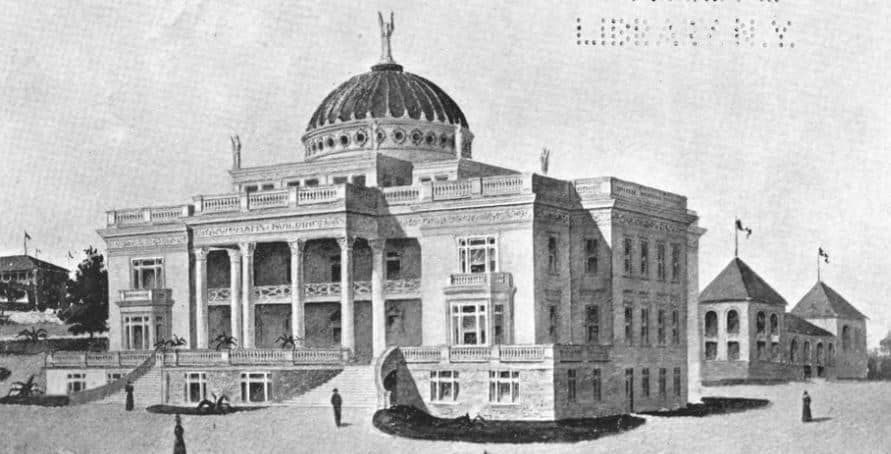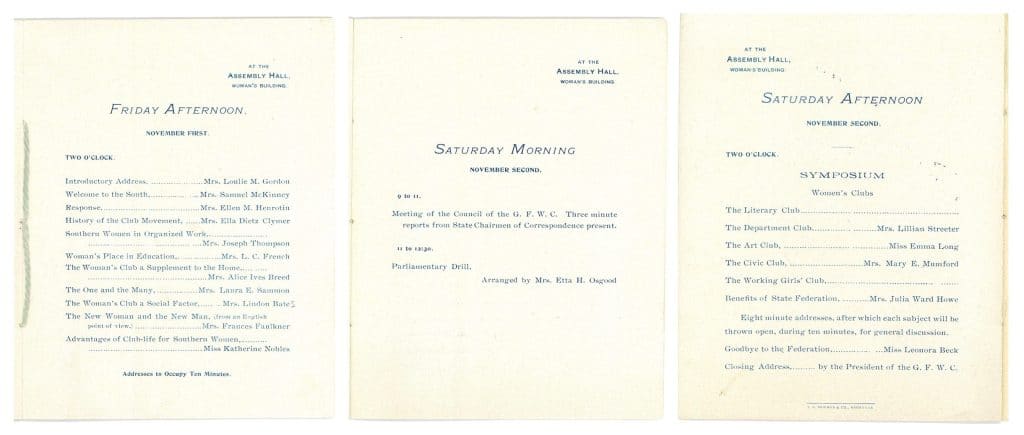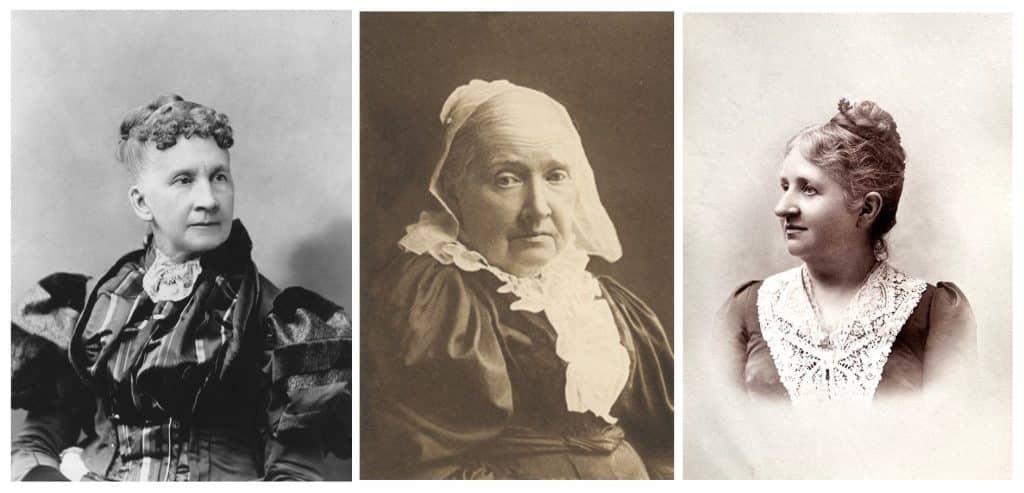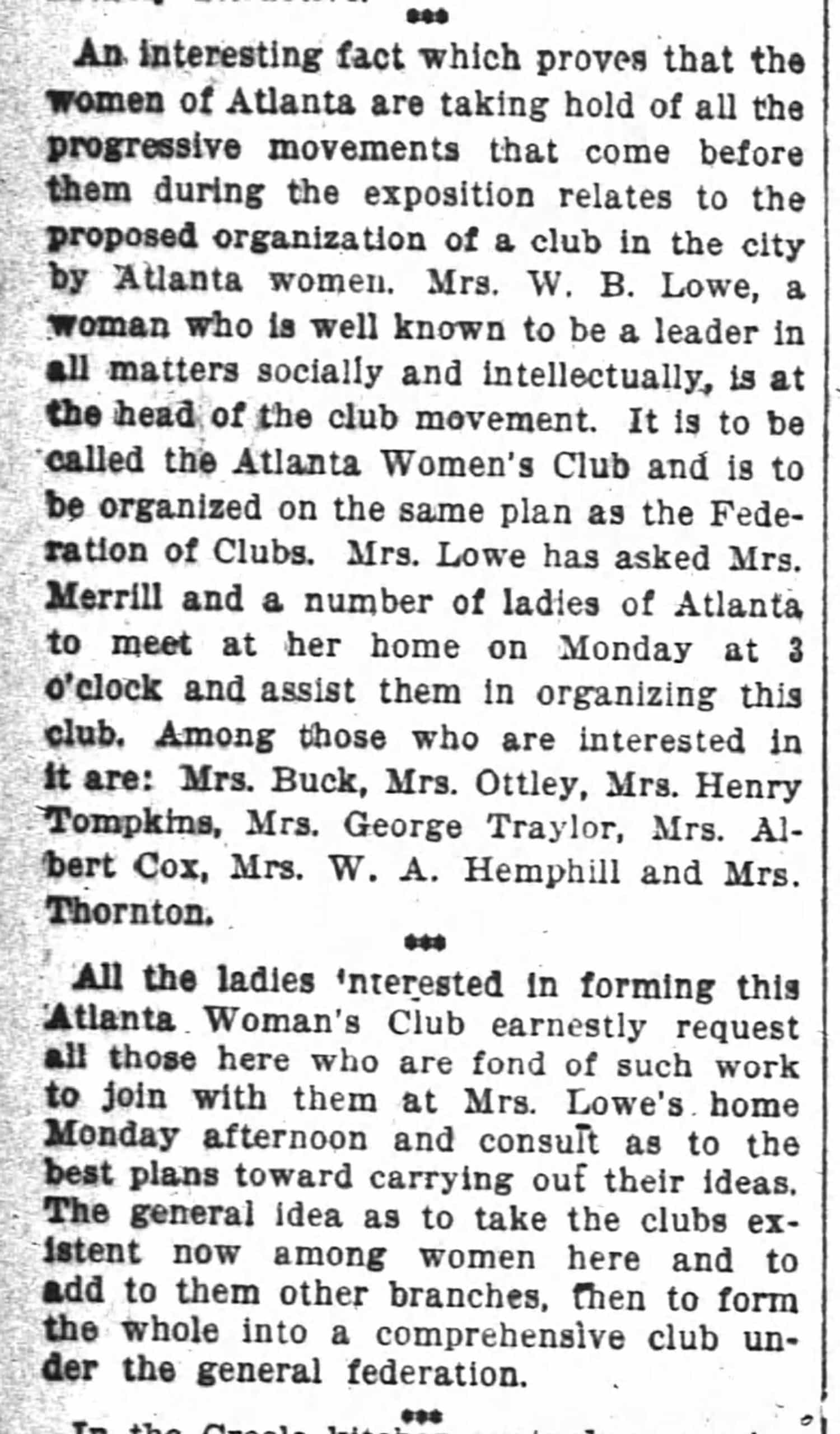GFWC in Atlanta, 130 Years Ago
By: Joanna Church, Women’s History and Resource Center Librarian
As of this blog’s posting, we are just days away from opening the General Federation of Women’s Clubs Annual Convention, held this year in Atlanta, Georgia. What better time to take a look at some of the convention materials in the Women’s History and Resource Center?

This will be our third full convention in Atlanta (having previously met there in 1994 and 2021), but looking further back in our history, the GFWC Board of Directors has convened in Atlanta several times: 1971, 1923, and 1895, just five years after our founding. That meeting 130 years ago was officially the “Congress of the General Federation of Women’s Clubs,” essentially a Board of Directors meeting, held over two busy November days in the midst of a much larger event, the Cotton States and International Exposition.
This Exposition, which took place from September to December, 1895, was a big deal for the growing city of Atlanta, and was part of a popular trend of expos and world’s fairs held across the country and the globe in the late 19th-early 20th centuries. The Expo was held in Piedmont Park and featured a Women’s Building (shown below) designed by architect Elise Mercur. It was in this building’s Assembly Hall that the GFWC “Congress” was held.

The only official publication from this meeting in our archives is the program (shown below), which provides the planned topics for discussion. Since this was still early days for GFWC, the speakers were focused promoting the broad concepts of women’s clubs: What kind of clubs exist? Why join (or create) a club? What can and should a club accomplish? And what are the benefits of federation?

As anyone who’s ever managed a major event knows, the things listed in the program are not always the things that happen in real life. Coverage of the meeting in newspapers helps to fill in the details, including updates to speakers and topics. The evening edition of the Atlanta Journal on Saturday, November 2nd, tells us that North Carolina’s Sallie Southall Cotten spoke on “The Relation of Women to Government,” for example. The paper also tells us that the “New Woman” speech planned for Friday afternoon was given by Belva Lockwood, a well-known attorney, and not the British woman named in the program.

Three of the speakers at the 1895 GFWC council meeting in Atlanta, Georgia, each shown circa 1895. Left: Belva Ann Lockwood (1830-1917), the first woman admitted to practice before the US Supreme Court. Center: Julia Ward Howe (1819-1910), poet, founder of the New England Woman’s Club, and first President of the Massachusetts Federation of Women’s Clubs. Right: Mary E. Mumford (1842-1935) of Philadelphia, Vice President of GFWC.
A longer recounting of the event can be found in the GFWC magazine, at that time called The New Cycle, in the December 1895 issue. The article describes the Expo in great detail, with frequent (and somewhat unflattering) comparisons to the much larger World’s Columbian Exposition held in Chicago two years earlier. It also details the two-day GFWC “Congress,” noting that the meeting “brought together a larger number of club leaders from different parts of the country than were ever gathered on a similar occasion.” It sounds like it was difficult to get the attendees to pay attention to “serious consideration of serious subjects” in the midst of the big, fun, busy Exposition, which may be why the official program of the “Congress” notes that most presentations will be less than ten minutes long. Though the article includes some presentations nearly verbatim, others are simply referenced as “the assigned papers, in order.”

Taken together, these primary sources give a good picture of an important event in early GFWC history. One major result of this meeting in Atlanta was an increased interest in club work among the women of Georgia, with an almost immediate impact on GFWC itself. At this point the south was not well-represented in GFWC membership (despite several charter clubs such as Ossoli Circle of Knoxville, Tennessee, and others). Our then-President, Ellen Henrotin of Chicago, chose to accept the invitation of the Expo’s Woman’s Department in the hopes of encouraging the spread of the woman’s club movement throughout the southern states. The New Cycle’s article notes that “Atlanta is not a club town,” but literally the day after the “Congress” wrapped up, attendee Rebecca Douglas Lowe was already at work organizing a new Atlanta Woman’s Club, which is still going strong today. Lowe herself went on to found the Georgia Federation the following year, and in 1898, just a few short years after the GFWC “Congress” held in her hometown, she was elected President of the General Federation of Women’s Clubs.
Left: Rebecca Douglas Lowe plans a new women’s club, from the Atlanta Constitution, November 3, 1895
Interested in reading The New Cycle’s coverage of the Expo, the “Congress,” and the first few weeks of the Atlanta Woman’s Club? Find it here!
Remember to check back next month for more stories from GFWC history (and present)! To learn more about the WHRC collections, visit the WHRC page or contact us at whrc@gfwc.org.
Joanna Church is the Women’s History and Resource Center Librarian at GFWC Headquarters in Washington, DC. She oversees the WHRC collection, handles research requests, and loves sharing our unique resources with fellow lovers of women’s history.
Learn More about the WHRC
The Women’s History and Resource Center